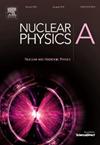127Xe的低j旋转带
IF 2.5
4区 物理与天体物理
Q2 PHYSICS, NUCLEAR
引用次数: 0
摘要
用束内γ射线能谱法研究了主要与低j νs1/2和νd3/2准粒子构型有关的低洼单准中子带。激发态是通过能量为15 MeV的2H光束轰击元素127I目标而填充的。这项研究证实了先前确定的、人口稀少的不受欢迎的νd3/2波段的特征伙伴,并为该波段内的两个低洼状态提供了确定的自旋和宇称分配。利用三轴投影壳模型进行的理论计算较好地再现了实验观测结果。本文章由计算机程序翻译,如有差异,请以英文原文为准。
Low-j rotational bands in 127Xe
Low-lying one-quasineutron bands, primarily associated with the low-j and quasiparticle configurations, have been investigated by means of in-beam -ray spectroscopy. Excited states were populated through the bombardment of a 2H beam with an energy of 15 MeV on an elemental 127I target. This study confirms the previously identified, feebly populated unfavoured signature partner of the band, and provides firm spin and parity assignments for two low-lying states within this band. Theoretical calculations using the Triaxial Projected Shell Model reproduce the experimental observations well.
求助全文
通过发布文献求助,成功后即可免费获取论文全文。
去求助
来源期刊

Nuclear Physics A
物理-物理:核物理
CiteScore
3.60
自引率
7.10%
发文量
113
审稿时长
61 days
期刊介绍:
Nuclear Physics A focuses on the domain of nuclear and hadronic physics and includes the following subsections: Nuclear Structure and Dynamics; Intermediate and High Energy Heavy Ion Physics; Hadronic Physics; Electromagnetic and Weak Interactions; Nuclear Astrophysics. The emphasis is on original research papers. A number of carefully selected and reviewed conference proceedings are published as an integral part of the journal.
 求助内容:
求助内容: 应助结果提醒方式:
应助结果提醒方式:


